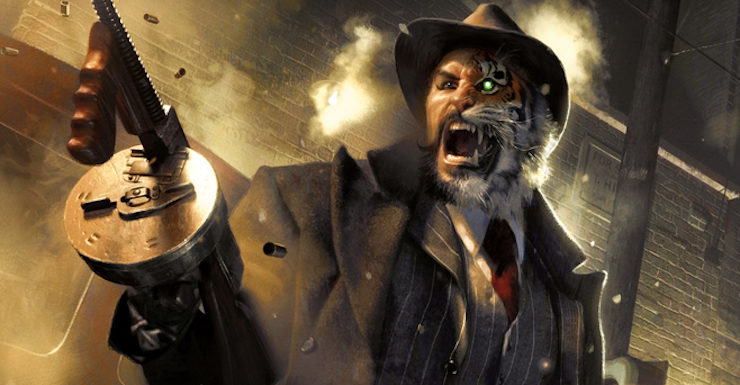Time. Time travel, time machines, temporal paradoxes, prophetic foretellings, space-time continuums. The concept of time pervades our various SFF genres, going back to the 19th century and appearing in much older mythologies as well. In many of these stories, time-related powers have been treated as world-changing and potentially universe-ending. Jump back with me, then, to 2018, when two books came out that treat the chronologically-powered in fun and thoughtful ways. George R.R. Martin’s Low Chicago is the only Wild Cards book to feature travel to the past (with all its paradoxical complications), while ‘time’ (without the travel) reoccurs as a major theme throughout K.D. Edwards’ Tarot Sequence books.
Fair warning: spoilers for Low Chicago, The Last Sun, and the Hanged Man below.
The Sleeper Throws a Wrench in the Timeline: Low Chicago
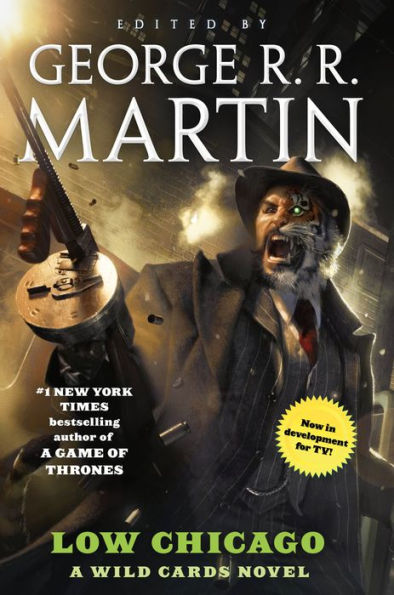
For more than 30 years, the books in the shared Wild Cards world have documented an alternative universe populated with aces and jokers, people empowered or damaged by an alien virus dropped in New York City in 1946. (For an intro to Wild Cards, go here.) The authors of the Wild Cards Consortium have said they made a conscious decision to never introduce a time-related superpower, as travel through time was a slippery plot point that could cause insurmountable headaches. But in 2018, the authors decided to make a single allowance for one trouble-making character whose powers would perforce be temporary, given the nature of his mutable wild card. For those who thought the Sleeper couldn’t top his days as Typhoid Croyd, his time-travel abilities this go-round are catastrophic on a Cyclopean scale.

The hotel is a fixed point in the temporal flux of Low Chicago.
Time travel is central to the Low Chicago plot. The characters at a high-stakes poker game in Chicago’s Palmer House are accidently scattered throughout the past. Chicago remains the setting for the entire book, and we get a long look at how the area has changed over the years: railroad yards where parks will be, rundown buildings where high-end brothels once stood, saber-tooth tigers roaming prehistoric pine forests.
Predictably, the various characters use their knowledge of the 21st century to survive, get ahead, or even alter historical events. The book is thus an adventure in the vein of Back to the Future II, where Biff changes the future by changing the past.
In this case, our heroes Croyd and Nighthawk must frantically search out the other chronologically misplaced characters. The two heroes skip through the years collecting the other wild carders, many of whom had actively attempted to remake the future. Their alterations, though, vary in scale, ranging from an individual-centered focus to the longue durée: Hardhat (the First) wants to save future murder victims by killing a would-be murderer; John Fortune uses his knowledge of movie history to find success in the early Chicago film industry.
Buy the Book
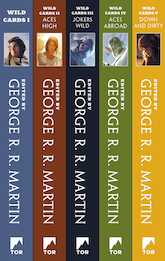

A Wild Cards Collection: Books I-V
It’s Paul Cornell’s laugh-out-loud trip to the age of the dinosaurs that flirts with the longue durée. Historians use this French term to describe historical change that happens over an extended period. Rather than historical transformations brought about through the actions of individuals, the ‘long duration’ approach to history considers change on a scale beyond the scope of human experience. Instead, it looks to change via slowly morphing social systems, gradual shifts in climates, mutating diseases, etc. Abigail Baker tells us after her time-jump, “I think it’s important to say, immediately, that I am in no way responsible for the extinction of the dinosaurs. I mean, yes, they went extinct, and yes, I was there, and yes, mistakes were made.” Just as the extinction-causing meteor pulverizes itself, we learn that Abigail did not alter geologic time, but may have brought the planet to the attention of aliens millions of years before the wild card virus-creating Takisians evolved. Whoops?
Croyd and Nighthawk end up forcing some of the timeline changers to “fix” what they’d done, including Khan the half-tiger, who’d foiled the original Valentine’s Day Massacre. Now, Marty McFly and Doc Brown could always go back in time to stop trouble, thanks to their DeLorean; the wild card world only has Croyd, and as everyone who has read the series knows, the Sleeper must, well, sleep, becoming ever more unreliable and crazed the closer he comes to his inevitable nap. The real problem in Low Chicago’s timeline arises when the social unrest of the 1960s, so crucial to Wild Cards (Book 1), results in a U.S. civil war, with an armed joker rebellion and captured aces in “camps.” Will Croyd set time to rights before he falls asleep?
Sadly, the time-hopping duo realize that in some cases the newly created alternative timelines have been changed for the better, yet nevertheless must be cancelled out. After watching the racially-integrated 1919 World Series, Nighthawk thinks:
It wasn’t a small thing, this breaking of the baseball color line decades before Jackie Robinson. It had tremendous implications, social, political, and economic, for his people, not to mention that it righted a great wrong that had kept deserving men from performing at the highest levels of their chosen profession. […] He and Croyd had to wipe it away. To erase it. To bring back an injustice that would harm the social fabric of the entire nation. […] But he would remember. He would remember the two hours or so of perfection, just a second or less in eternity, but something of beauty and grace that was an accomplishment for the ages.
The Tarot Sequence: The Last Sun and The Hanged Man, but no Lord Time
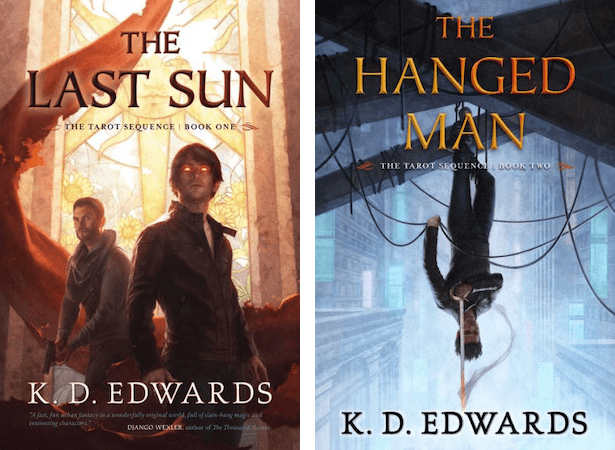
The world of the Tarot Sequence likewise recognizes the danger of “time,” which has been a major theme in the series to date. The books’ exceptionally vivid characters—led by Rune (the heir of the Sun Throne) and his companion, Brand—populate New Atlantis, the refugee city on Nantucket colonized after the Atlantean home island became uninhabitable. Edwards’ world abounds with rich allusions to the past and future, but without the overt time travel motif so central to Low Chicago and other SFF narratives.
In the Tarot Sequence world, the twenty-two Arcana are archetypes (who, yes, inspired human tarot cards). A long-ago Arcana had been Time, who ruled the Hourglass Throne from Farstryke Castle. Rune visits this desolated building in The Last Sun; we learn that the court of the Hourglass had been dismantled for crimes against humanity. What those crimes may have been, we’re not told, but readers can naturally assume there was some inappropriate messing about with established chronologies. In the second book, The Hanged Man, it becomes clear that time magic is considered anathema, so much so that its use is a capital offense. The misuse of time magic has a more substantial role in this book’s storyline, with Rune, Brand, and their crew helping to bring down the Hanged Man himself for his temporal misdeeds. Careful readers will find hints that the concept of “time” (or Time?) will continue as a major element in the series.
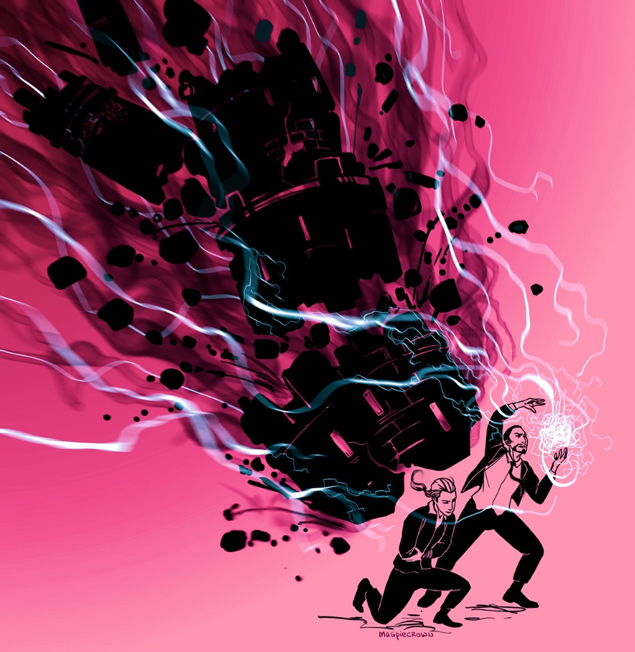
For an author whose work exhibits such an interest in history, there is a surprising absence of conspicuous time travel up to this point in Edwards’ series. He gets around this by layering the past into the very landscape of the world. Many of the most important structures in New Atlantis consist of buildings from recent human history. Many were the sites of disasters or have a compelling aura, and were thus magically reappropriated by the Atlanteans when they began to settle Nantucket in the 20th century: these include the Bangkok Ghost Tower, the Pacific Bell Building, Beacon Towers, and many others. Edwards’ love of historically interesting sites extends to ships, with the Green Docks surrounded by lost boats from various human eras, including a plot-significant WWII aircraft carrier.
And while these locations provide the opportunity for atmospheric spaces from times long gone, history really comes to the fore at those New Atlantis places which are haunted or otherwise suffused with erstwhile echoes of the past. A reoccurring place in the series is Riverside Hospital, formerly of New York City, now filled with ghosts and spiritual impressions left from events that impacted the hospital, such as the 1904 General Slocum disaster. The ghosts plaguing Farstryke Castle, on the other hand, are much more aggressive; it is here that we get our closest look at the past—not of the human world, but of the Atlantean home island. Farstryke had been translocated from Old Atlantis, now brimming with ghosts. When he’s brushed by these passing spirits, Rune unwillingly shares memories of Old Atlantis, where he’s never once set foot: “Maria’s crooked smile, the cherry tree in my Atlantean orchard, Adeem’s first pony being fed plums the size of coconuts.” Without the possibility of time travel, will these echoes provide our only “first person” view of the lost Atlantis from long ago?
While the time travelers in Low Chicago never once jumped to the future beyond 2018, in the Tarot Sequence, the future is a palpable presence through the words and minds of Atlantean seers. The teenage prophet Quinn is a major character, one of the unbelievably rare prophets who can see probabilities, and thus he witnesses many versions of what’s to come. In fact, Quinn observes so many possible events, that he talks about the future as if it’s his own lived experience. He tells Rune:
I forgot. You don’t like seers. But you like me anyway. You kissed me on the eyebrow once. And you’ll hit the bully with a barstool after he calls me a freak. Or at least you do most of the time. Sometimes Addam grabs the stool first. Once I was very brave and kicked him in the shin myself.
Why doesn’t Rune like seers? Because, like every good Chosen One, he finds himself plagued by oracles. Brand bemoans the fact that “Rune can’t swing a dead cat without hitting a fucking prophecy.” He’s so “hip-fucking-deep in prophecies” that we hear about various foretellings whose details can’t yet be revealed. Rune asks Quinn:
“Why can’t you or won’t you tell me?”
“Because it’s not my role.”
“Whose role is it, then?”
“Time,” Quinn said sadly. “Time will show you.”
***
So there you have it: two intriguing recent examples of narratives that explore our relationship with history and the potential dangers of changing or tampering with time, each in their own unique way. What are some of your favorite treatments of time in SFF, and what did you like about them?
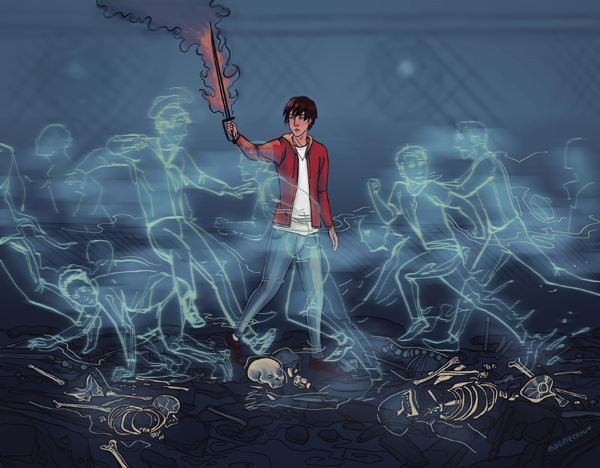
Katie Rask is an assistant professor of archaeology and classics at The Ohio State University. She’s excavated in Greece and Italy for over 15 years.










